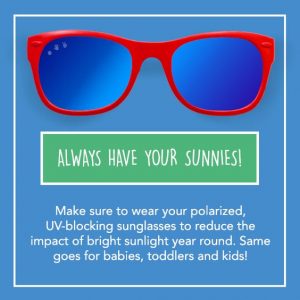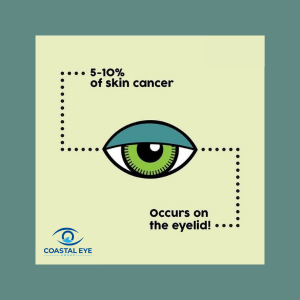A Hot Month for A Hot Issue
July is the hot month and UV safety is the hot issue.
Did you know that July is UV Safety Awareness Month?
July is the perfect month to bring awareness to this topic because most of us are outside embracing the warm summer days but we are not protecting our skin and eyes from damage caused by excessive exposure to the sun’s UV rays. UV Safety Awareness Month is to educates the public on the importance of protecting our eyes from the sun every time we go outside, no matter your age, location, or the time of year it is.

The sun releases energy (radiation) in many forms, such as the sunlight we see and the heat we feel from the sun. A third form of radiation from the sun is UV (ultraviolet) rays. UV rays are invisible to the eye but they can be very damaging to your eyes and hurt your vision after long periods of exposure. There are two types of UV rays: UV-A and UV-B both of which can cause a number of eye problems. UV-A radiation can hurt your central vision by damaging the macula, which is a part of the retina in the back of your eye. Meanwhile, UV-B radiation is mostly absorbed by the front of your eye (the cornea and lens) and has the ability to cause even more damage to your eyes than UV-A radiation. Both types of UV rays radiate directly from the sun but can also be reflected from the ground, water, snow, sand, or any other bright surfaces, hence the importance of wearing eye protection the location or time of year you are in. Since UV rays can come from any direction and any surface, it is important to wear the proper eye protection. This important for every person at every age (even children), because anyone who spends time outside is at risk for eye damage from UV radiation.
We frequently hear about the important of wearing sunscreen anytime we are in the sun to protect our skin from being damaged by the sun’s UV radiation and potentially causing cancer. What we do not hear about as much is protecting our eyes from the sun’s UV radiation as well. Many people do not know that excessive unprotected exposure of their eyes to UV rays can result in skin cancer on the eyelids along with premature aging of the delicate skin around their eyes. Most eyelid skin cancers occur on the lower lid, because it receives the most sun exposure. If left untreated, eyelid skin cancers can become dangerous and disfiguring, with the potential to cause tissue damage and blindness. In addition to skin cancer on the eyelid, UV radiation has the potential to lead to other serious eye conditions, such as:
- Cataracts – When the natural lens of the eye gets cloudy and causes progressive vision loss; this is the most common cause of treatable blindness.
- Macular degeneration – A major cause of vision loss as you get older, caused by cumulative UV damage to the central portion of the retina where what we see if recorded and sent to the brain to process.
- Keratitis (corneal sunburn) – A temporary inflammation of the cornea (the clear covering of the front of the eye), when the eye is severely sunburned. It’s important to remember that eyes can get sunburned the same way skin can.
- Conjunctival cancers – Can grow on the surface of the eyeball and usually starts from the membrane that covers most of the eye called the conjunctiva. The most common conjunctival cancers are squamous carcinoma, malignant melanoma and lymphoma.

These are all serious yet treatable conditions as long as they are tended to in a timely manner. Do not leave these eye condition untreated and turn into a dangerous and disfiguring situation. Better yet, do not even put yourself in the position to develop these eye conditions. You can easily embrace some simple actions and make them a habit in your life in order to safely enjoy the beautiful outdoors while protecting the health and safety of your eyes and the delicate skin around them.

